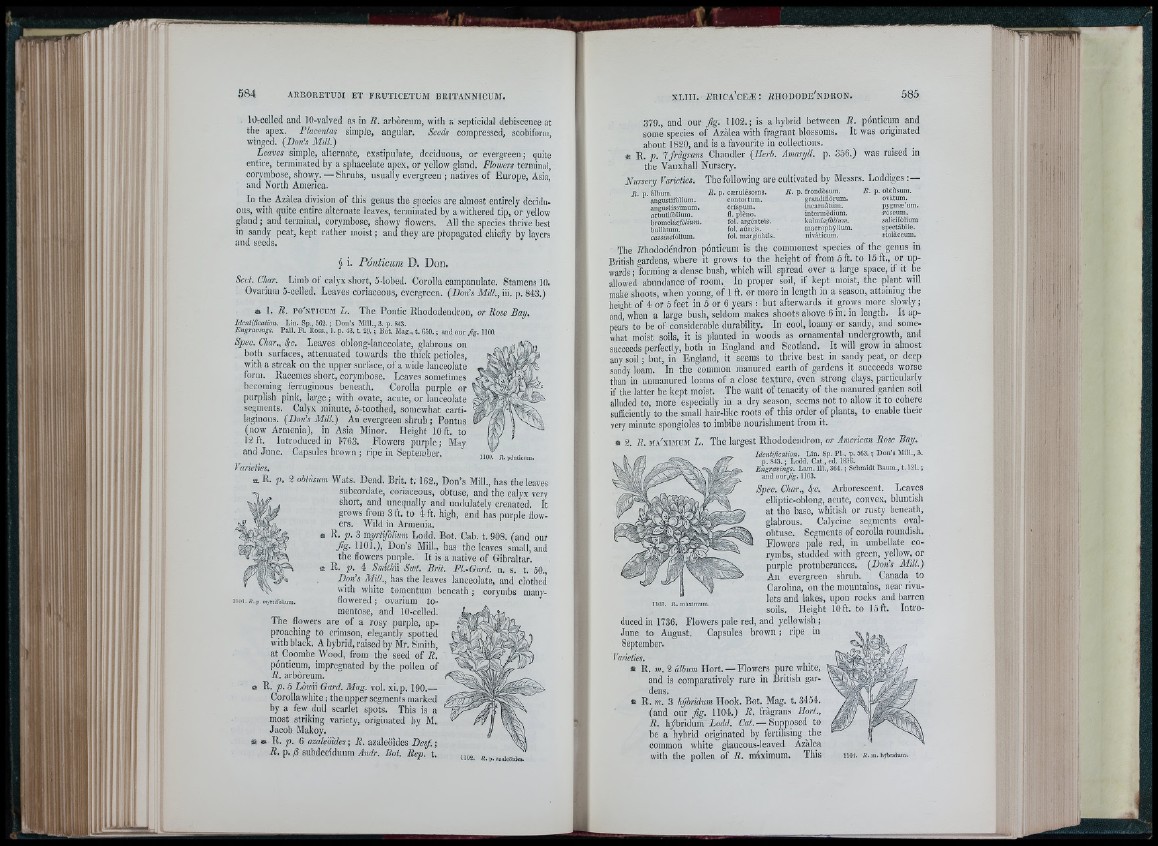
lOrCelled and ÌO~va!ved as in R. arboreum, with a sejitlcidal deliiscence at
the apex. Placentas simple, anguiar. Seeds compressed, scobiibrni,
winged. {Doris Mill.)
Lcavcs simple, alternate, exstipulate, deciduous, or evergreen ; quite
entire, terminated by a sphacelate apex, or yellow gland. Flowers terminal,
corymbose, showy. — Shrubs, usually evergreen ; natives of Europe, Asia,
and North America.
In the Azalea division of this genus the species are almost entirely deciihi-
ous, with quite entire alternate leaves, terminated by a withered tip, or yellow
gland; and terminal, corymbose, showy flowers. All the species thrive best
in sandy peat, kept rather inoist; and they are propagated chiefly by layers
and seeds.
i. Pónticum D . D o n .
Sect.Char. Limb of calyx short, o-lobed. Corolla campanulate. Stamens 10.
Ovarium 5-celled, Leaves coriaceous, evergreen. {Don's Mill., iii. p. 843.)
tt 1. R. Po'xNTiouM L. The Pontic Rhododendron, or Rose Bay,
Identification. Lin. Sp., 562. ; Don’s Mill., 3. p. 843.
Engravings. Pall. Fl. Ross., I . p. 43. t. 29. ; Bot. Mag., t. 650. ; and our j
Spec. Char., 4^ Leaves oblong-lanceolate, glabrous on
both surfaces, attenuated towards the thick petioles,
with a streak on the upjier surface, of a wide lanceolate
form. ^ Racemes short, corymbose. Leaves .sometimes
becoming ferruginous beneath. Corolla purple or
purplish pink, large; with ovate, acute, or lanceolate
segments. Calyx minute, 5-toothed, somewhat cartilaginous.
(Don's Mill.) An evergreen shrub ; Pontus
(now Armenia), in Asia Minor. Height 10 ft. to
12ft. Introducedin 1-763. Flowers purple; May
and June, Capsules brown ; ripe in September.
Varieties.
t tR . j). 2 ohthsnm Wats. Dend. Brit. t. 162., Don’s Mill., has theleaves
subcordate, coriaceous, obtuse, and the calyx very
short, and unequally and undulately crenated. It
grows from 3 ft. to 4 ft. high, and has purple flowers.
Wild in Armenia,
tt R. p. 3 myrtifbUum Lodd. Bot. Cab. t. 908. (and our
Jig, 1101.), Don’s Mill., has the leaves small, and
the flowers purple. It is a native of Gibraltar,
ts R. jj. 4 SmithW Swt. Brit. Fl.-Gard. n. s. t. 50.,
Doris Mill., has the leaves lanceolate, and clothed
with white tomentum beneath ; corymbs many-
, . flowered ; ovarium to mentose,
and 10-celled.
The flowers are of a rosy purple, approaching
to crimson, elegantly spotted
with black. A hybrid, raised by Mr. Smith,
at Coombe Wood, from the seed of R.
ponticum, impregnated by the pollen of
R. arboreum.
a R. / . 5 Lown Gard. Mag. vol. xi. p. 190.—
Corolla white; the upper segments marked
by a few dull scarlet spots. This is a
most striking variety, originated by M.
Jacob Makoy.
^ tt R. p . 6 ozaleozdes; R. azaleoides Desf. ;
R. p. /3 siibdeciduum Aiulr. Bot. Rep. t.
379., and our Jig. 1102. ; is a liybrid between B. ponticurn and
some species of Azalea with fragrant blossoms. I t was originated
about 1820, and is a favourite in collections.
R. p . 1 fràgrans Chandler {Herb. Amaryll. p. 356.) was raised in
the Vauxhall Nursery.
The following are cultivated by Nursery Varieties, Messrs. Loddiges : —
It, p. álbum.
angustifòlium.
angustissimum.
«rbutifòUum.
bromel icefùlium.
buUàtum.
crtssinefôlium.
R . p. cæruléscens.
contoitum.
fl. p?èno.
fol. argentéis,
fol. aúreis.
fol. m.Trginàtis.
R . p. frondòsum. R. p. obtùsum.
grandiflòrum. ovàtum.
incarnâtnm. pj'gmæ'um.
intermèdium. ròseum.
\a\\niiefÒlium. salicifòHum
macrophyllum. spectábile.
nivâticum. iiiiiioollàceum.
The Bhododdndron pontioum is the commonest species of the genus in
British gardens, where it grows to the height of f r o m / t . to 15 ft., oarr uupp-wards
; forming a dense biish, which will spread over a large space, if it be
allowed abundance of room. In proper soil, if kept inoist, the plant will
make shoots, when young, of 1 ft. or more in length in a season, attaining the
height of 4 or 5 feet in 5 or 6 years ; but afterwards it grows more slowly;
and", when a large bush, seldom makes shoots above Gin. in length. It appears
to be of considerable durability. In cool, loamy or sandy, and somewhat
moist soils, it is planted in woods as ornamental undergrowth, and
succeeds perfectly, both in England and Scotland. It will grow m almost
any soil ; but, in England, it seems to thrive best in sandy peat, or deep
sandy loam. In the common manured earth of gardens it succeeds worse
than in unmanured loams of a close texture, even strong clays, particularly
if the latter be kept moist. Tlie want of tenacity of the manured garden soil
alluded to, more especially in a dry season, seems not to allow it to cohere
sufficiently to the small hair-like roots of this order of plants, to enable their
vveerrvy mmiinnuuttee ssppoonnggiioolleess ttoo iimbibe nourishment from it.
2. B. m a 'x im u m L. The largest Rhododendron, or American Rose Bay.
Identification. Lin. Sp. P1-, p. 563. ; D
p. 843.; Lodd. C a t, ed. 18.36.
Engravmgs. L.im. III.,364. ; Schmidt Baum., 1.121. ;
and o u r /g . 1103.
Spec. Char., 4c. Arborescent. Leaves
elliptic-oblona, acute, convex, bluntish
at the base, whitish or rusty beneath,
glabrous. Calycine segments oval-
obtuse. Segments of corolla roundish.
Flowers jiale red, in umbellate corymbs,
studded with green, yellow, or
purple protuberances. {Don's Mill.)
An evergreen shrub. Canada to
Carolina, on the mountains, near rivulets
and lakes, upon rocks and barren
soils. Fleight 10ft. to 15ft. Intro-
(luced in 1736. Flowers pale red, and yellowish ;
June to August, Capsules brown ; ripe in
September.
Varieties.
» R. m. 2 album Hort. — Flowers pure white,
and is comparatively rare in British gardens.
« R. m. 3 hybridum Hook. Bot. Mag. t. 3454.
(and our Jig. 1104.) R. fràgrans Hort.,
R. hybridum Lodd. Cat. — Supposed to
be a hybrid originated by fertilising the
common white glaucous-leaved Azalea
with the pollen of R. màximum. This
1101. H. in. h jb n d um .
â